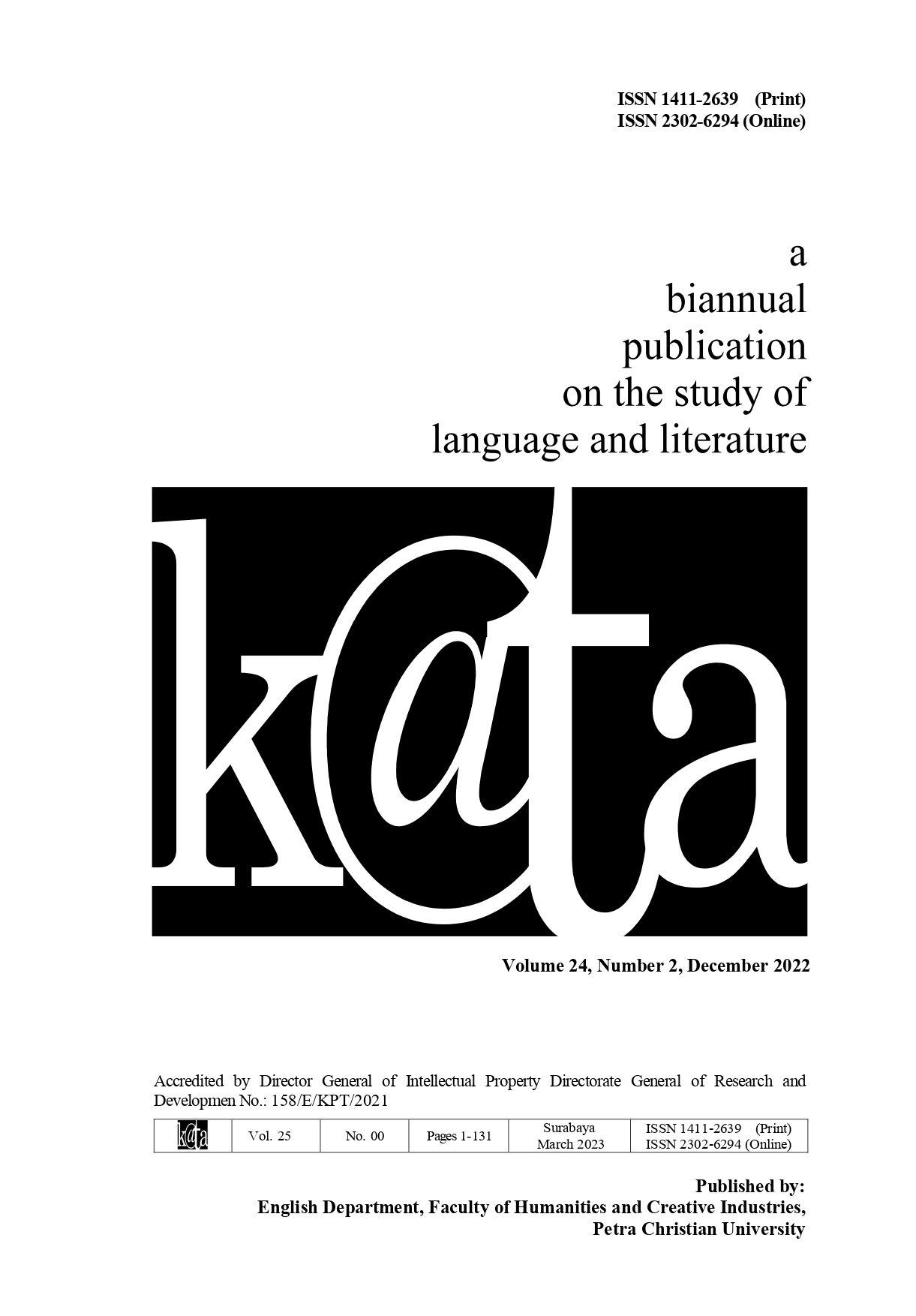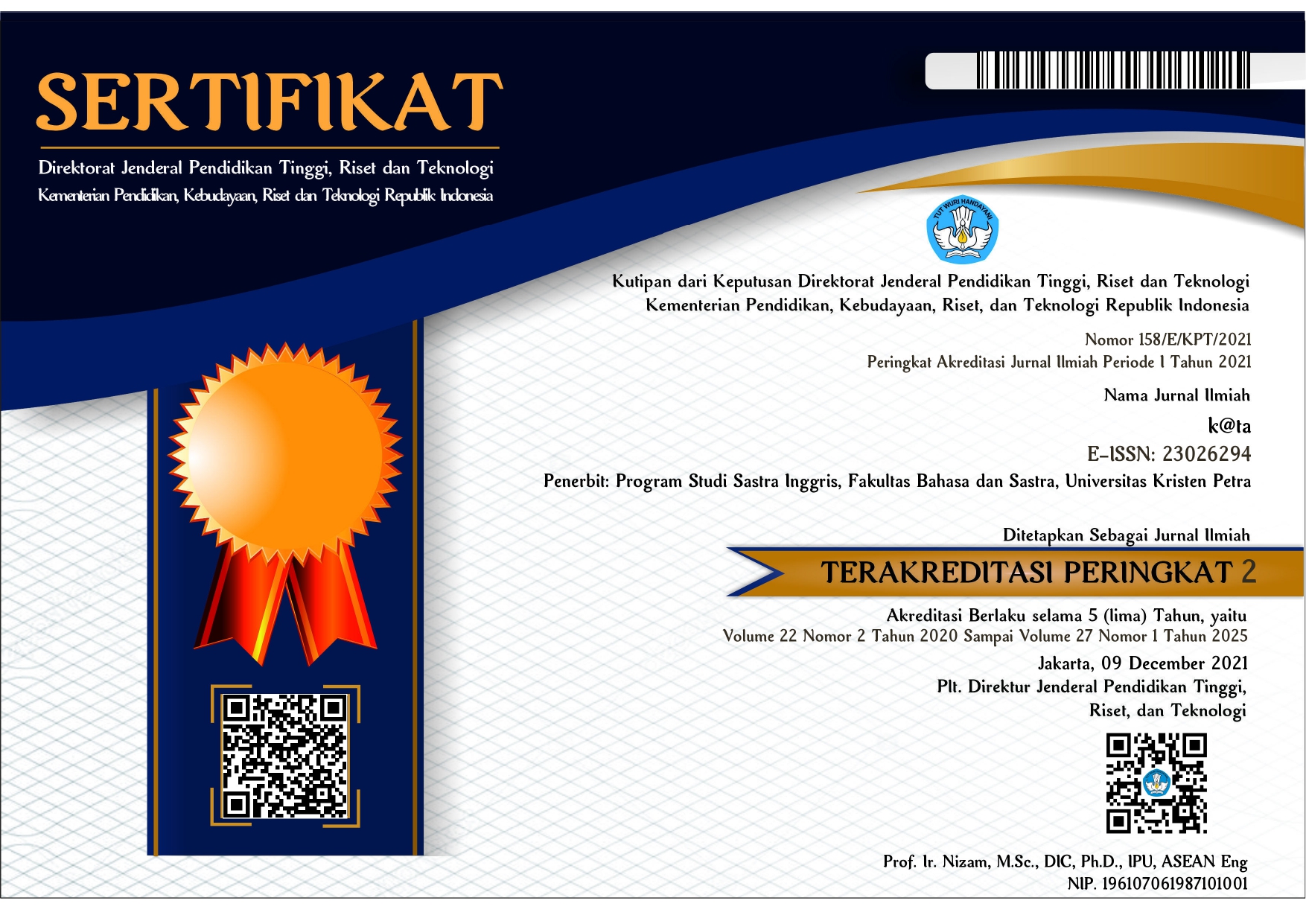English Language Teaching in Indonesia: Monolingual and Multilingual Practices
Abstract
21st century urges one’s ability to tacitly navigate the increasingly complex linguistic spaces of this modern world and it results in super diverse society (Gallagher, 2020). Kachru’s (1986, as cited in Wardhaugh & Fuller, 2015) arrives with the conceptual framework named world of Englishes. It becomes such pivotal consideration to drive today’s language ideology, including Indonesian. This literature review then aims at unveiling Indonesian EFL teachers’ views about monolingual and multilingual practices by capitalizing English language teaching classroom as the context. Data were derived from relevant research reports that meet the criteria. Criteria comes in threefold. They were conducted in any range of time, were obtained from catch-all indexing, and were done in Indonesian setting. The findings come in agreement that both monolingualism and multilingualism yielded two camps: justifying it and rejecting it in Indonesian EFL context. Implication is then needed to further validate it in accordance with empirical research’s result.
Downloads
References
Algeo, J., & Butcher, C. A. (2013). The origins and development of the English language. Cengage Learning.
Arnaut, K., Blommaert, J., Rampton, B., & Spotti, M. (Eds.). (2015). Language and superdiversity. Routledge.
Auer, P., & Wei, L. (Eds.). (2007). Handbook of multilingualism and multilingual communication (Vol. 5). Mouton de Gruyter.
Auerbach, E. R. (1993). Reexamining English only in the ESL classroom. TESOL quarterly, 27(1), 9-32.
Azir, I.D.A. (2019). Should the Use of Bahasa Indonesia Be Allowed in the EFL Classroom?. System. 10-20.
Bin-Tahir, S. Z., Atmowardoyo, H., Dollah, S., & Rinantanti, Y. (2017). Multilingual learning program: Pesantren students’ perceptions of the multilingual simultaneous-sequential model. JELE (Journal of English Language and Education), 3(2), 44-53.
Cenoz, J. (2013). Defining multilingualism. Annual review of applied linguistics, 33, 3-18.
Cenoz, J., & Gorter, D. (2006). Linguistic landscape and minority languages. In Linguistic Landscape (pp. 67-80). Multilingual Matters.
Bonnin, J. E. (2013). New dimensions of linguistic inequality: An overview. Language and Lingu-istics Compass, 7(9), 500-509.
Canagarajah, S., & Liyanage, I. (2012). Lessons from pre-colonial multilingualism. In The Routledge handbook of multilingualism (pp. 67-83). Routledge.
Cole, S. (1998). The use of L1 in communicative English classrooms. LANGUAGE TEACHER-KYOTO-JALT-, 22, 11-14.
Cook, V. (2016). Where is the native speaker now? TESOL Quarterly, 50(1), 186-189.
Crystal, D. (2008). A dictionary of linguistics and phonetics: Sixth Edition. Blackwell Publishing.
Cummins, J. (2007). Rethinking monolingual instruc-tional strategies in multilingual classrooms. Canadian Journal of Applied Linguistics, 10(2), 221-240.
Dardjowidjojo, S. (2000). English teaching in Indone-sia. EA journal.
Dardjowidjojo, S. (2003). The role of English in Indo-nesia: A dilemma. In K.E. Sukamto (Ed), Rampai bahasa, pendidikan, dan budaya: Kumpulan esai Soenjono Dardjowidjojo [Enthusiasm of language, education, and culture: A collection of essays by Soenjono Dardjowidjojo], pp. 41-50. Yayasan Obor Indonesia.
Eaton, S. E. (2010). Global trends in language learning in the 21st century. Onate Press.
Effendy, M. B., & Fahri. (2019). Using webtoon comic as media in teaching reading narrative text for junior high school students. Retain, 7(3).
Ekawati, S. M., & Setyarini. M.C.E. (2014). Students’ attitude toward monolingual approach in English classes. Satya Wacana Christian University Journal. 1-14.
Ellis, E. M. (2016). “I may be a native speaker but I'm not monolingualâ€: Reimagining all teachers' linguistic identities in TESOL. Tesol Quarterly, 50(3), 597-630.
Ewert, A. (2008). 3. L1 syntactic preferences of polish adolescents in bilingual and monolingual education programmes (pp. 47-62). Multilingual Matters.
Fandiño, F. G. E., Muñoz, L. D., & Velandia, A. J. S. (2019). Motivation and e-learning English as a foreign language: A qualitative study. Heliyon, 5(9), e02394.
Gallagher, F. (2020). Considered in context: EFL teachers’ views on the classroom as a bilingual space and codeswitching in shared-L1 and in multilingual contexts. System, 91, 102262.
GarcÃa, O. (2009). Emergent bilinguals and TESOL: What's in a name? Tesol Quarterly, 43(2), 322-326.
GarcÃa, O., & Lin, A. M. (2017). Translanguaging in bilingual education. Bilingual and multilingual education, 117-130.
GarcÃa, O., Flores, N., & Woodley, H. H. (2015). 10 Constructing inbetween spaces to ‘do’bilingualism: a tale of two high schools in one city. Multilingual education, 199.
GarcÃa, O., & Wei, L. (2014). Language, bilingualism, and education (pp. 46-62). Palgrave Macmillan UK.
Harmer, J. (2015). The Practice of English Language Teaching. Pearson.
Haryanto, E., Sulistiyo, U., Khairani, M., & Wulan, R. (2016). Indonesian or English? EFL student teachers’ preference and perception on the language use in the classroom. IJEE (Indonesian Journal of English Education), 3(1), 46-59.
Haugen, E. (2012). Language planning in modern Norway. In Readings in the Sociology of Language (pp. 673-687). De Gruyter Mouton.
Herdina, P., & Jessner, U. (2002). A dynamic model of multilingualism: Perspectives of change in psy-cho¬¬linguistics (Vol. 121). Multilingual Matters.
Hickmann, M., & Robert, S. (Eds.). (2006). Space in languages: Linguistic systems and cognitive categories (Vol. 66). John Benjamins Publishing.
Hornberger, N. H., & McKay, S. (Eds.). (2010). Sociolinguistics and language education (Vol. 18). Multilingual Matters.
Joseph, M., & Ramani, E. (2006). English in the world does not mean English everywhere: The case for multilingualism in the ELT/ESL profession. English in the world: Global rules, global roles, 186-199.
Kachru, B. B. (1986). The power and politics of English. World Englishes, 5(2â€3), 121-140.
Kachru, Y. (1994). Monolingual bias in SLA research. Tesol Quarterly, 28(4), 795-800.
Kidwell, T. (2021). Protectors and preparers: novice Indonesian EFL teachers’ beliefs regarding teaching about culture. Language and Intercultural Communication, 1-15.
Lähteenmäki, M., Varis, P., & Leppänen, S. (2011). The shifting paradigm: towards a reconceptualisation of multilingualism. Apples-Journal of Applied Language Studies.
Lauder, A. (2008). The status and function of English in Indonesia: A review of key factors. Makara Human Behavior Studies in Asia, 12(1), 9-20.
Lee, J. H., & Lo, Y. Y. (2017). An exploratory study on the relationships between attitudes toward classroom language choice, motivation, and proficiency of EFL learners. System, 67, 121-131.
Lie, A. (2007). Education policy and EFL curriculum in Indonesia: Between the commitment to competence and the quest for higher test scores. TEFLIN journal, 18(1), 01-15.
Lie, A. (2017). English and Identity in Multicultural Contexts: Issues, Challenges, and Opportunities. TEFLIN Journal: A Publication on the Teaching & Learning of English, 28(1).
Liebscher, G., & Daileyâ€O'Cain, J. (2009). Language attitudes in interaction 1. Journal of sociolinguis-tics, 13(2), 195-222.
Llurda, E. (2005). Looking at the perceptions, challenges, and contributions... or the importance of being a non-native teacher. In Non-Native Language Teachers (pp. 1-9). Springer.
Lotherington, H., & Jenson, J. (2011). Teaching multimodal and digital literacy in L2 settings: New literacies, new basics, new pedagogies. Annual review of applied linguistics, 31, 226-246.
Lucas, T., & Katz, A. (1994). Reframing the debate: The roles of native languages in Englishâ€only programs for language minority students. TESOL Quarterly, 28(3), 537-561.
Manara, C. (2007). The use of L1 support: Teachers’ and students’ opinions and practices in an Indonesian context. The Journal of Asia TEFL, 4(1), 145-178.
Manara, C. (2014). That‘s what worries me: Tensions in English language education in today‘s Indonesia. International Journal of Innovation in English Language Teaching and Research, 3(1), 21-35.
Margana, M. (2016). Voices of English teachers and students on blended culture as a model of English language teaching and learning at vocational high schools in Yogyakarta. Mediterranean Journal of Social Sciences, 7(3), 459-459.
MartÃ, H., Pérez-Bárcena, J., Fiol, M., Marrugat, J., Navarro, C., Aldasoro, E., & Elosua, R. (2005). Analysis with the propensity score of the association between likelihood of treatment and event of interest in observational studies. An example with myocardial reperfusion. Revista Española de CardiologÃa (English Edition), 58(2), 126-136.
May, S. (2014). Contesting public monolingualism and diglossia: Rethinking political theory and language policy for a multilingual world. Language policy, 13(4), 371-393.
McMillan, B., & Turnbull, M. (2009). Teachers’ use of the first language in French immersion: Revisiting a core principle. In First language use in second and foreign language learning (pp. 15-34). Multilingual Matters.
Myers-Scotton, C. (1993). Elite closure as a powerful language strategy: The African case. Inter¬national journal of the sociology of language, 1993(103), 149-164.
Pardede, P. (2018). Use of Mother Tongue in EFL Classes of Secondary Schools In Jabodebek: Students' and Teachers' Perception. JET (Journal of English Teaching), 4(2), 62-80.
Piller, I. (2016). Monolingual ways of seeing multilingualism. Journal of Multicultural Discourses, 11(1), 25-33.
Rasman, R. (2018). To translanguage or not to translanguage? The multilingual practice in an Indonesian EFL classroom. Indonesian Journal of Applied Linguistics, 7(3), 687-694.
Renandya, W. A., Hamied, F. A., & Nurkamto, J. (2018). English language proficiency in Indonesia: Issues and prospects. Journal of Asia TEFL, 15(3), 618.
Setyabudi, T. (2017, December). Language Policy in Indonesia. Proceedings of ISETH 2017 (The 3rd International Conference on Science, Techno-logy, and Humanity.
Shin, N. (2018). Child heritage speakers’ morpho-syntax: Rate of acquisition and crosslinguistic influence. The Routledge handbook of Spanish as a heritage language, 235-253.
Sridhar, S. N. (1994). A reality check for SLA theories. TESOL quarterly, 28(4), 800-805.
Sundari, H., & Febriyanti, R. H. (2021). Translation techniques and translation competence in translating informative text for Indonesian EFL learners. Scope: Journal of English Language Teaching, 1(1), 17-28.
Troyan, F. J., & Sembiante, S. F. (2020). Developing a Critical Functional Linguistic Knowledge Base for World Language Teachers. In Genre in World Language Education (pp. 32-61). Routledge.
Wardhaugh, R., & Fuller, J. M. (2015). An Introduc-tion to Linguistics. Wiley Blackwell.
Wei, L. (2011). Moment analysis and translanguaging space: Discursive construction of identities by multilingual Chinese youth in Britain. Journal of pragmatics, 43(5), 1222-1235.
Wulyani, A. N., Elgort, I., & Coxhead, A. (2019). Ex-ploring EFL teachers’ English language proficiency: Lessons from Indonesia. Indonesian Journal of Applied Linguistics, 9(2), 263-274.
Zacharias, N. T. (2003). A survey of tertiary teachers’ beliefs about English language teaching in Indonesia with regard to the role of English as a global language. Unpublished MA Thesis, Thailand University, August, 126.
Zein, S. (2020). Language policy in superdiverse Indonesia. Routledge.
Zein, S., Sukyadi, D., Hamied, F. A., & Lengkanawati, N. S. (2020). English language education in Indonesia: A review of research (2011–2019). Language Teaching, 53(4), 491-523.

This work is licensed under a Creative Commons Attribution 4.0 International License.
![]() This work is licensed under a Creative Commons Attribution License
This work is licensed under a Creative Commons Attribution License




.png)
.png)

.png)












